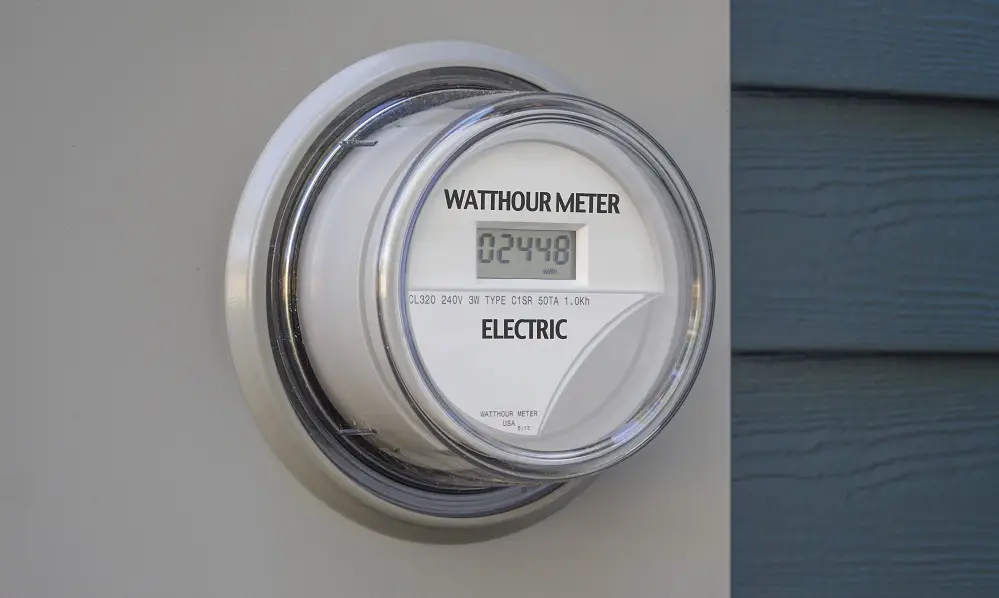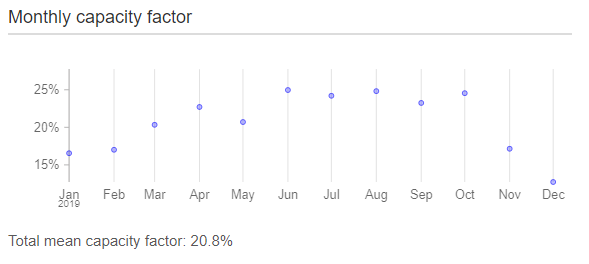There are a number of factors to consider when working out how many solar panels are required to power your home. For example – the average number of hours of sunlight your home receives over the year – dependent on where you live.
Also, if you want to go completely off-grid and power your home 24 hours a day, 7 days a week, all year round, then you will also need to look at energy storage, since solar panels will only generate during the day.
Table of Contents
How Many Solar Panels Do I Need?
In order to determine how many solar panels your house needs, there are two important pieces of information that need to be identified:
- How much energy your home uses in total over the course of a year, measured in kilowatt-hours (kWh)
- The maximum power your home uses at any one time, measured in kilowatts (kW)
The first of these can be found out by looking at two utility bill statements that are 1 year apart. The kWh meter reading from the first year is subtracted from the kWh meter reading in the second year, and this gives the total number of kWh used during the year. An average US home uses 10,649 kWh per year (2019 data).
The second needs to be measured directly by looking at your electricity meter.
The Difference Between Kilowatts (kW) and Kilowatt-hours(kWh)
Many people get confused by the difference between kilowatts (kW) and kilowatt-hours (kWh) – they are different, and the difference is important.
The kilowatt rating of an electrical device (eg., a washing machine, fridge/freezer, electric kettle etc) tells you how fast that device uses electricity all the time it is turned on. If an electric kettle is labelled at, say, 1.5kW, then that means that while it is switched on, it is consuming electricity at a rate of 1.5kW (or 1500Watts denoted as 1500W). However, this doesn’t tell you how much electricity it used in total, since that depends on how long it was switched on for.
Likewise, a solar panel is also rated in kW – or more usually, just Watts (W). This tells you the rate at which the panel generates electricity. The longer it stays in sunshine, the more kWh it generates in total. The most powerful commercially available solar panel as of June 2021 is the Trinasolar Vertex, which is rated at 670W.
Kilowatt-hours tells you a total amount of electricity that has been used up or generated. Your electric bill is measured in kWh since this is the total amount of electricity your premises has used over the whole billing period (usually quarterly).
A 670W solar panel that has been in full sun for 8 hours generates a total of 670W x 8 = 5.36kWh
Measuring Power Usage: Smart Meters vs Traditional Meters

You need to know the maximum kW rating your home can pull from the grid at any one time. Your home will not pull this amount all the time, but we need a worse-case scenario in case the dishwasher is on at the same time as the air conditioner, at the same time as the tumble drier, at the same time as the power-washer, for example.
Trying to find this out on a traditional electricity meter is very hard, if not impossible, since they do not display a kW reading. A digital electricity meter has a flashing light that usually flashes once for every 1Wh (0.001kWh) that is used. The faster the light flashes, the faster the electricity is being used, and the higher the kW value. So for example, if it flashes once per second, that is 1Wh per sec = 3600W (or 3.6kW).
Modern smart meters are usually supplied with a table-top monitor that does all this for you, and gives you a readout of the rate at which your premises is using electricity, in W or kW. You can read this value at various times during the day, and see when it is highest – this is your kW rate.
Without any energy storage system, this is the minimum amount of kW of you need from your solar panels. Let’s say for example you have observed a maximum kW rate of 15kW for your home. You simply divide this number by the power rating of your solar panels to work out the minimum number of panels you need.
Assuming you are buying the most powerful solar panels currently available (670W), to achieve 15kW, you would need a minimum 24 solar panels (24 x 670W = 16.08kW). Of course, if the sun isn’t shining, even with 24 solar panels you wouldn’t be generating 15kW.
Total Mean Capacity Factor
The total amount of electricity a solar panel generates over the course of a year (the kWh) depends on how much direct sunlight it receives.
This calculator/website, Renewables.ninja, calculates the solar power effectiveness anywhere on the earth, calculated as the ‘total mean capacity factor’, which is a combination of how many hours of sunlight and how much cloud cover any given location receives.
Learn More: Do Solar Panels Require Direct Sunlight?
For example, a solar panel on a roof in Nevada has a solar total mean capacity factor of 20.8%. This means that the solar panel can be expected to generate its full power capacity for 20.8% of the year. Whereas the same panel on a roof in Alaska has a total mean capacity factor of 10.1% - generating less than half the amount of electricity as the same panel in Nevada.

You need to make sure that the panels make enough total electricity each day to match the total amount of electricity your home uses during that day. Taking the US average yearly total of 10,649kWh, this works out at 10649kWh / 365 days = 29kWh used per day (just over).
In Nevada, at 20.8% capacity factor, one 670W solar panel generates an average 3.34kWh per day (670W x 24 hours x 20.8%). This means you would need 9 solar panels to achieve an average 29kWh per day – whereas in Alaska, you would need 18 solar panels. This is still less than the 24 solar panels calculated above, since most of the time, the home will be pulling far less than the maximum kW, but the panels need to be able to deliver the maximum if it is ever needed.
Energy Storage: Solar Power Overnight
To truly go off-grid, an energy storage system is required. Domestic energy storage systems like the Tesla Powerwall are designed to store excess solar power that is generated during the day for use during night.
These systems are rated in both kW and kWh. This is because they have a maximum rate at which they can deliver power (the kW) and they also have a maximum total amount of energy that can be stored in them (the kWh).
The kW rating must exceed the maximum kW rating for your home (15kW as in the example above), or else your home may try and pull power from the system faster than the system can deliver it, which would cause a shut down to prevent damage occurring. Note that with an energy storage system, you can get away with using less solar panels. Any sudden increases in electricity demand are compensated for by the system temporarily drawing power from storage.
The kWh value of the storage system is the total amount of electrical energy that can be stored in the system when it is fully charged. During the day, if your solar panels are generating power at a faster rate of Watts than your home is using them, the overflow is used to charge the energy storage system. Then, when the sun goes down and the solar panels stop generating, the energy stored in the system is used to power your home.
There needs to be enough electricity stored in the system to keep your home powered throughout the night until the sun comes up the next day and the panels start generating again.
The simplest way to find this value is to take a note of your electricity meter kWh reading at sundown, and then take another reading at sunrise. The difference between these two is the total amount of electricity your house has used overnight.
Say you record a value of 6kWh. This means your energy storage system has to have a minimum capacity of 6kWh to ensure it can store enough electricity to keep your house powered throughout the night.
In addition, your solar panels must produce a minimum of 6kWH of overflow power every day to charge the system up with power to use during the night. During the darker winter months, there are fewer daylight hours, and the lower position of the sun in the sky means the solar panels will generate less electricity than the summer months.
Learn More: Do Solar Panels Work in Winter?
Going Off-grid 365 Days a Year
To go off-grid year round requires substantially more energy storage, because sufficient excess energy needs to be generated during the summer to be stored for half a year to use during the winter months.
Over winter, solar panels will generate approximately 1/10th of the kWh they generate over the summer months (this varies depending on where you and the panels are located). Assuming an average daily domestic electricity consumption of 29kWh, during the summer months your solar panels would need to be generating 55.1kWh per day to ensure that enough overflow was generated to store for the winter months. In Nevada, for example, you would need 17 solar panels to achieve the 55.1kWh required; In Alaska, 34 panels.
You would also need 6 months’ worth of energy storage capacity – at 29kWh per day, assuming 1/10th generation during winter, this works out at 4763kWh of energy storage required. For the vast majority of domestic cases, this would be unfeasible.
References
- https://www.eia.gov/
- https://www.cleanenergyreviews.info/
- https://www.tesla.com/
- Image Credit Renewables.ninja shared under License: CC BY-NC 4.0
- Data Sources: http://gmao.gsfc.nasa.gov/ and https://dx.doi.org/

